
The Second Wave at Sunset, North Coyote Buttes. The Second Wave, a curiously-shaped sandstone swirl, takes on rich warm tones and dramatic shadowed textures at sunset. Set in the North Coyote Buttes of Arizona and Utah, the Second Wave is characterized by striations revealing layers of sedimentary deposits, a visible historical record depicting eons of submarine geology.
Location: North Coyote Buttes, Paria Canyon-Vermilion Cliffs Wilderness, Arizona
Image ID: 20606
Location: North Coyote Buttes, Paria Canyon-Vermilion Cliffs Wilderness, Arizona
Image ID: 20606

A Florida manatee, or West Indian Manatee, swims slowly through the clear waters of Crystal River.
Species: West indian manatee, Trichechus manatus
Location: Three Sisters Springs, Crystal River, Florida
Image ID: 02696
Species: West indian manatee, Trichechus manatus
Location: Three Sisters Springs, Crystal River, Florida
Image ID: 02696

Paradise Falls tumble over rocks in Paradise Creek.
Location: Paradise Creek, Mount Rainier National Park, Washington
Image ID: 13867
Location: Paradise Creek, Mount Rainier National Park, Washington
Image ID: 13867

Ocean sunfish recruiting fish near drift kelp to clean parasites, open ocean, Baja California.
Species: Ocean sunfish, Mola mola
Image ID: 03267
Species: Ocean sunfish, Mola mola
Image ID: 03267

A white tern, or fairy tern, alights on a branch at Rose Atoll in American Samoa.
Species: Fairy tern, Gygis alba
Location: Rose Atoll National Wildlife Sanctuary, American Samoa
Image ID: 00871
Species: Fairy tern, Gygis alba
Location: Rose Atoll National Wildlife Sanctuary, American Samoa
Image ID: 00871

Tiger shark and horse-eye jacks.
Species: Tiger shark, Galeocerdo cuvier
Location: Bahamas
Image ID: 31880
Species: Tiger shark, Galeocerdo cuvier
Location: Bahamas
Image ID: 31880

Bristlecone pine displays its characteristic gnarled, twisted form as it rises above the arid, dolomite-rich slopes of the White Mountains at 11000-foot elevation. Patriarch Grove, Ancient Bristlecone Pine Forest.
Species: Bristlecone Pine, Pinus longaeva
Location: White Mountains, Inyo National Forest, California
Image ID: 17475
Species: Bristlecone Pine, Pinus longaeva
Location: White Mountains, Inyo National Forest, California
Image ID: 17475

Bigeye trevally jacks, motion blur, schooling.
Species: Bigeye jack, Caranx sexfasciatus
Location: Darwin Island, Galapagos Islands, Ecuador
Image ID: 16347
Species: Bigeye jack, Caranx sexfasciatus
Location: Darwin Island, Galapagos Islands, Ecuador
Image ID: 16347

San Diego city skyline at sunset, showing the buildings of downtown San Diego rising above San Diego Harbor, viewed from Harbor Island. A panoramic photograph, composite of thirteen separate images.
Location: San Diego, California
Image ID: 22255
Panorama dimensions: 4759 x 15430
Location: San Diego, California
Image ID: 22255
Panorama dimensions: 4759 x 15430

The Second Wave at Sunset, Vermillion Cliffs. The Second Wave, a curiously-shaped sandstone swirl, takes on rich warm tones and dramatic shadowed textures at sunset. Set in the North Coyote Buttes of Arizona and Utah, the Second Wave is characterized by striations revealing layers of sedimentary deposits, a visible historical record depicting eons of submarine geology.
Location: North Coyote Buttes, Paria Canyon-Vermilion Cliffs Wilderness, Arizona
Image ID: 28613
Location: North Coyote Buttes, Paria Canyon-Vermilion Cliffs Wilderness, Arizona
Image ID: 28613

The bright orange garibaldi fish, California's state marine fish, is also clownlike in appearance.
Species: Garibaldi, Hypsypops rubicundus
Location: California
Image ID: 02416
Species: Garibaldi, Hypsypops rubicundus
Location: California
Image ID: 02416

The Second Wave at sunset. The Second Wave, a curiously-shaped sandstone swirl, takes on rich warm tones and dramatic shadowed textures at sunset. Set in the North Coyote Buttes of Arizona and Utah, the Second Wave is characterized by striations revealing layers of sedimentary deposits, a visible historical record depicting eons of submarine geology.
Location: North Coyote Buttes, Paria Canyon-Vermilion Cliffs Wilderness, Arizona
Image ID: 28614
Location: North Coyote Buttes, Paria Canyon-Vermilion Cliffs Wilderness, Arizona
Image ID: 28614

Parasitic zoanthid anemones cover, encrust and overwhelm a golden gorgonian. The gorgonian on the left has been completely parasitized by zoanthid anemones, while the gorgonian to the right remains free of zoanthids (for now). A garibaldi swims below the two sea fans. The golden gorgonian is a filter-feeding temperate colonial species that lives on the rocky bottom at depths between 50 to 200 feet deep. Each individual polyp is a distinct animal, together they secrete calcium that forms the structure of the colony. Gorgonians are oriented at right angles to prevailing water currents to capture plankton drifting by.
Species: California golden gorgonian, Luminescent parazoanthid, Zoanthid anemone, Giant kelp, Muricea californica, Parazoanthus lucificum, Savalia lucifica, Macrocystis pyrifera
Location: San Clemente Island, California
Image ID: 38493
Species: California golden gorgonian, Luminescent parazoanthid, Zoanthid anemone, Giant kelp, Muricea californica, Parazoanthus lucificum, Savalia lucifica, Macrocystis pyrifera
Location: San Clemente Island, California
Image ID: 38493
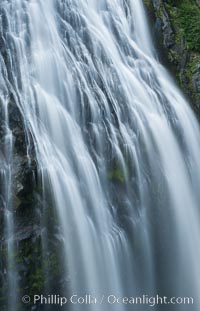
Narada Falls cascades down a cliff, with the flow blurred by a time exposure. Narada Falls is a 188 foot (57m) waterfall in Mount Rainier National Park.
Location: Narada Falls, Mount Rainier National Park, Washington
Image ID: 28718
Location: Narada Falls, Mount Rainier National Park, Washington
Image ID: 28718

The Second Wave at Sunset, Vermillion Cliffs. The Second Wave, a curiously-shaped sandstone swirl, takes on rich warm tones and dramatic shadowed textures at sunset. Set in the North Coyote Buttes of Arizona and Utah, the Second Wave is characterized by striations revealing layers of sedimentary deposits, a visible historical record depicting eons of submarine geology.
Location: North Coyote Buttes, Paria Canyon-Vermilion Cliffs Wilderness, Arizona
Image ID: 28619
Location: North Coyote Buttes, Paria Canyon-Vermilion Cliffs Wilderness, Arizona
Image ID: 28619

Giant Manta Ray at San Benedicto Island, Revillagigedos, Mexico.
Species: Giant manta ray, Manta birostris
Location: San Benedicto Island (Islas Revillagigedos), Baja California, Mexico
Image ID: 33276
Species: Giant manta ray, Manta birostris
Location: San Benedicto Island (Islas Revillagigedos), Baja California, Mexico
Image ID: 33276

Two Adult Male Lions Fight to Establish Territory, Greater Masai Mara, Kenya. Both of these large males emerged from the battle with wounds, and it was not clear who prevailed.
Species: African lion, Panthera leo
Location: Mara North Conservancy, Kenya
Image ID: 39699
Panorama dimensions: 5135 x 8390
Species: African lion, Panthera leo
Location: Mara North Conservancy, Kenya
Image ID: 39699
Panorama dimensions: 5135 x 8390

Royal Tern in flight, adult breeding plumage with black head cap, La Jolla.
Species: Royal tern, Sterna maxima, Thalasseus maximus
Location: La Jolla, California
Image ID: 38946
Species: Royal tern, Sterna maxima, Thalasseus maximus
Location: La Jolla, California
Image ID: 38946
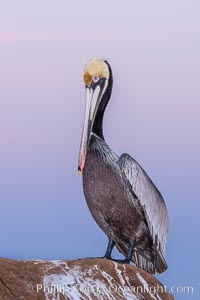
California brown pelican, portrait in pink-purple predawn light, rests on sandstone seabluff. The characteristic breeding plumage of the California race of brown pelican is shown, with red gular throat pouch and dark brown hindneck colors.
Species: Brown Pelican, Pelecanus occidentalis, Pelecanus occidentalis californicus
Location: La Jolla, California
Image ID: 23646
Species: Brown Pelican, Pelecanus occidentalis, Pelecanus occidentalis californicus
Location: La Jolla, California
Image ID: 23646

California brown pelican, showing characteristic winter plumage including red/olive throat, brown hindneck, yellow and white head colors.
Species: Brown Pelican, Pelecanus occidentalis, Pelecanus occidentalis californicus
Location: La Jolla, California
Image ID: 26462
Species: Brown Pelican, Pelecanus occidentalis, Pelecanus occidentalis californicus
Location: La Jolla, California
Image ID: 26462

Water falling from the fluke (tail) of a humpback whale as the whale dives to forage for food in the Santa Barbara Channel.
Species: Humpback whale, Megaptera novaeangliae
Location: Santa Rosa Island, California
Image ID: 27029
Species: Humpback whale, Megaptera novaeangliae
Location: Santa Rosa Island, California
Image ID: 27029
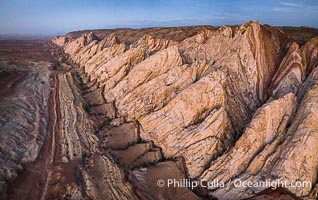
Aerial photo of the San Rafael Reef at dawn. A fold in the Earth's crust leads to this inclined section of the San Rafael Reef, at the eastern edge of the San Rafael Swell. Clearly seen are the characteristic triangular flatiron erosion patterns that typical this formation. The colors seen here arise primarily from Navajo and Wingate sandstone.
Location: Utah
Image ID: 39787
Location: Utah
Image ID: 39787
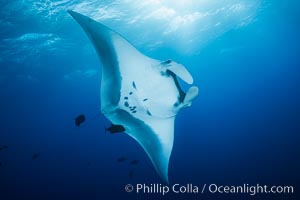
Giant Manta Ray at Socorro Island, Revillagigedos, Mexico.
Species: Giant manta ray, Manta birostris
Location: Socorro Island (Islas Revillagigedos), Baja California, Mexico
Image ID: 33285
Species: Giant manta ray, Manta birostris
Location: Socorro Island (Islas Revillagigedos), Baja California, Mexico
Image ID: 33285

One of the male lions of the River Pride, Mara Triangle, Kenya.
Species: African lion, Panthera leo
Location: Mara North Conservancy, Kenya
Image ID: 39704
Panorama dimensions: 5760 x 8640
Species: African lion, Panthera leo
Location: Mara North Conservancy, Kenya
Image ID: 39704
Panorama dimensions: 5760 x 8640
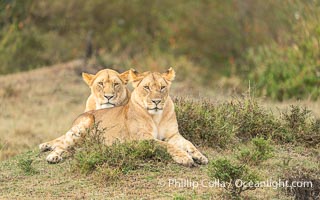
Portrait of Two Sibling Lions of the River Pride, Mara North Conservancy, Kenya.
Species: African lion, Panthera leo
Location: Mara North Conservancy, Kenya
Image ID: 39729
Panorama dimensions: 5400 x 8640
Species: African lion, Panthera leo
Location: Mara North Conservancy, Kenya
Image ID: 39729
Panorama dimensions: 5400 x 8640

Royal Tern in flight, adult non-breeding plumage, La Jolla.
Species: Royal tern, Sterna maxima, Thalasseus maximus
Location: La Jolla, California
Image ID: 38952
Species: Royal tern, Sterna maxima, Thalasseus maximus
Location: La Jolla, California
Image ID: 38952

Blackside hawkfish on hard coral, Paracirrhites forsteri, close-up, Fiji.
Species: Blackside hawkfish, Paracirrhites forsteri
Location: Namena Marine Reserve, Namena Island, Fiji
Image ID: 34759
Species: Blackside hawkfish, Paracirrhites forsteri
Location: Namena Marine Reserve, Namena Island, Fiji
Image ID: 34759

Closeup Portrait of the Face of a Giant Black Sea Bass, showing parasitic sea lice. These parasites find their nutrition from the skin and blood of the host giant sea bass. Smaller fishes such as senoritas and wrasses will commonly clean the sea lice off the giant sea bass.
Species: Giant black sea bass, Stereolepis gigas
Location: Catalina Island, California
Image ID: 39436
Species: Giant black sea bass, Stereolepis gigas
Location: Catalina Island, California
Image ID: 39436
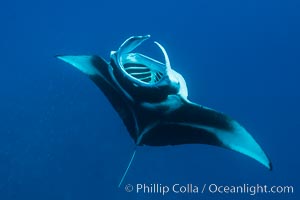
Manta Ray Feeding on Plankton, Fiji.
Species: Giant manta ray, Manta birostris
Location: Gau Island, Lomaiviti Archipelago, Fiji
Image ID: 31323
Species: Giant manta ray, Manta birostris
Location: Gau Island, Lomaiviti Archipelago, Fiji
Image ID: 31323

Giant Manta Ray at Socorro Island, Revillagigedos, Mexico.
Species: Giant manta ray, Manta birostris
Location: Socorro Island (Islas Revillagigedos), Baja California, Mexico
Image ID: 33291
Species: Giant manta ray, Manta birostris
Location: Socorro Island (Islas Revillagigedos), Baja California, Mexico
Image ID: 33291